I know this questions has been asked before but I could not find my answer anywhere.
the thing is I have below code on my asmx file:
namespace IrancellSmsServer
{
[SoapDocumentService(RoutingStyle = SoapServiceRoutingStyle.RequestElement)]
[WebService(Namespace = "http://www.csapi.org/schema/parlayx/data/sync/v1_0/local")]
[WebServiceBinding(ConformsTo = WsiProfiles.BasicProfile1_1)]
[System.ComponentModel.ToolboxItem(false)]
public class SoapServer : System.Web.Services.WebService
{
[WebMethod]
public syncOrderRelationResponse syncOrderRelation(
Sync.UserID userID,
string spID,
string productID,
string serviceID,
string serviceList,
int updateType,
string updateTime,
string updateDesc,
string effectiveTime,
string expiryTime,
item[] extensionInfo
)
{
syncOrderRelationResponse a = new syncOrderRelationResponse();
a.result = 0;
a.resultDescription = "OK";
return a;
}
}
}
And this is the result:
<?xml version="1.0" encoding="utf-8"?>
<soap:Envelope xmlns:soap="http://schemas.xmlsoap.org/soap/envelope/" xmlns:xsi="http://www.w3.org/2001/XMLSchema-instance" xmlns:xsd="http://www.w3.org/2001/XMLSchema">
<soap:Body>
<syncOrderRelationResponse xmlns="http://www.csapi.org/schema/parlayx/data/sync/v1_0/local">
<syncOrderRelationResult> //dont want this
<result>0</result>
<resultDescription>OK</resultDescription>
</syncOrderRelationResult> //dont want this
</syncOrderRelationResponse>
</soap:Body>
</soap:Envelope
the problem is I dont want that extra <syncOrderRelationResult> tag that .net created automatically. I want it completely remove. I have tried [SoapDocumentMethod(ParameterStyle=SoapParameterStyle.Bare)]
but no luck it tels me I should have one parameter. is there any way I could do this?
expected result:
<?xml version="1.0" encoding="utf-8"?>
<soap:Envelope xmlns:soap="http://schemas.xmlsoap.org/soap/envelope/" xmlns:xsi="http://www.w3.org/2001/XMLSchema-instance" xmlns:xsd="http://www.w3.org/2001/XMLSchema">
<soap:Body>
<syncOrderRelationResponse xmlns="http://www.csapi.org/schema/parlayx/data/sync/v1_0/local">
<result>0</result>
<resultDescription>OK</resultDescription>
</syncOrderRelationResponse>
</soap:Body>
</soap:Envelope
here is the code of syncOrderRelationResponse:
namespace IrancellSmsServer.Sync {
using System;
using System.Web.Services;
using System.Diagnostics;
using System.Web.Services.Protocols;
using System.Xml.Serialization;
using System.ComponentModel;
/// <remarks/>
[System.CodeDom.Compiler.GeneratedCodeAttribute("System.Web.Services", "4.6.1055.0")]
[System.Diagnostics.DebuggerStepThroughAttribute()]
[System.ComponentModel.DesignerCategoryAttribute("code")]
[System.Web.Services.WebServiceBindingAttribute(Name="DataSyncBinding", Namespace="http://www.csapi.org/wsdl/parlayx/data/sync/v1_0/service")]
public partial class DataSyncService : System.Web.Services.Protocols.SoapHttpClientProtocol {
private bool useDefaultCredentialsSetExplicitly;
/// <remarks/>
public DataSyncService() {
this.Url = global::IrancellSmsServer.Properties.Settings.Default.IrancellSmsServer_Sync_DataSyncService;
if ((this.IsLocalFileSystemWebService(this.Url) == true)) {
this.UseDefaultCredentials = true;
this.useDefaultCredentialsSetExplicitly = false;
}
else {
this.useDefaultCredentialsSetExplicitly = true;
}
}
public new string Url {
get {
return base.Url;
}
set {
if ((((this.IsLocalFileSystemWebService(base.Url) == true)
&& (this.useDefaultCredentialsSetExplicitly == false))
&& (this.IsLocalFileSystemWebService(value) == false))) {
base.UseDefaultCredentials = false;
}
base.Url = value;
}
}
public new bool UseDefaultCredentials {
get {
return base.UseDefaultCredentials;
}
set {
base.UseDefaultCredentials = value;
this.useDefaultCredentialsSetExplicitly = true;
}
}
/// <remarks/>
[System.Web.Services.Protocols.SoapDocumentMethodAttribute("", Use=System.Web.Services.Description.SoapBindingUse.Literal, ParameterStyle=System.Web.Services.Protocols.SoapParameterStyle.Bare)]
[return: System.Xml.Serialization.XmlElementAttribute("syncOrderRelationResponse", Namespace="http://www.csapi.org/schema/parlayx/data/sync/v1_0/local")]
public syncOrderRelationResponse syncOrderRelation([System.Xml.Serialization.XmlElementAttribute("syncOrderRelation", Namespace="http://www.csapi.org/schema/parlayx/data/sync/v1_0/local")] syncOrderRelation syncOrderRelation1) {
object[] results = this.Invoke("syncOrderRelation", new object[] {
syncOrderRelation1});
return ((syncOrderRelationResponse)(results[0]));
}
/// <remarks/>
public void syncOrderRelationAsync(syncOrderRelation syncOrderRelation1, object userState) {
if ((this.syncOrderRelationOperationCompleted == null)) {
this.syncOrderRelationOperationCompleted = new System.Threading.SendOrPostCallback(this.OnsyncOrderRelationOperationCompleted);
}
this.InvokeAsync("syncOrderRelation", new object[] {
syncOrderRelation1}, this.syncOrderRelationOperationCompleted, userState);
}
}
/// <remarks/>
[System.CodeDom.Compiler.GeneratedCodeAttribute("System.Xml", "4.6.1055.0")]
[System.SerializableAttribute()]
[System.Diagnostics.DebuggerStepThroughAttribute()]
[System.ComponentModel.DesignerCategoryAttribute("code")]
[System.Xml.Serialization.XmlTypeAttribute(Namespace="http://www.csapi.org/schema/parlayx/data/sync/v1_0/local")]
public partial class syncOrderRelationResponse {
private int resultField;
private string resultDescriptionField;
//private item[] extensionInfoField;
/// <remarks/>
public int result {
get {
return this.resultField;
}
set {
this.resultField = value;
}
}
/// <remarks/>
public string resultDescription {
get {
return this.resultDescriptionField;
}
set {
this.resultDescriptionField = value;
}
}
/// <remarks/>
//[System.Xml.Serialization.XmlArrayItemAttribute("item", Form=System.Xml.Schema.XmlSchemaForm.Unqualified, IsNullable=false)]
//public item[] extensionInfo {
// get {
// return this.extensionInfoField;
// }
// set {
// this.extensionInfoField = value;
// }
//}
}
/// <remarks/>
public syncOrderRelationResponse Result {
get {
this.RaiseExceptionIfNecessary();
return ((syncOrderRelationResponse)(this.results[0]));
}
}
}
}
}
